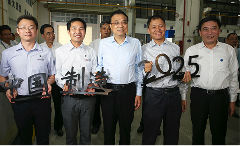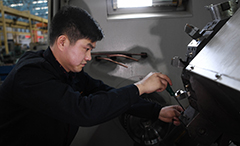‘Made in China’ policy boosted by manufacturing upgrade
2017-02-21
China Daily
Initiative aims to achieve industrial breakthroughs and increase nation’s competitiveness
China is to further promote the manufacturing sector after recently releasing 11 guidelines to implement the “Made in China 2025” strategy, with a focus on areas such as smart manufacturing, high-end equipment, new materials and branding.
An initiative, known as “1+X”, was finished earlier this month with 11 guidelines published, according to the Ministry of Industry and Information Technology. The “1” stands for “Made in China 2025” and “X” refers to guidelines for 11 subsectors, including smart and green manufacturing and innovation of high-end equipment.
More than 20 State Council departments participated in the initiative, which aims to achieve breakthroughs in the manufacturing sector and boost the country’s competitiveness from a “world factory” to a true manufacturing power, encompassing design to production.
These guidelines aim to be suggestions instead of administrative requirements, endowing the market a bigger role in resource allocation, and calling for joint efforts by the government, enterprises, research institutes and universities as well as financial institutions.
“Made in China 2025” was first proposed by Premier Li Keqiang in his Government Work Report in March 2015. The Premier has reiterated the plan on many occasions and promoted the upgrading of China’s manufacturing sector to be environmentally-friendly, cost-effective and high-end.
In a written instruction last year, the Premier called for the lowering of the threshold for market access, the better allocation of resources and reduced costs for the development of advanced manufacturing industries. He also encouraged the integration of “Made in China 2025” with initiatives such as internet Plus, mass entrepreneurship and innovation, with an emphasis on craftsmanship.
At a State Council executive meeting on April 6, the Premier said efforts should be made to boost consumer confidence in domestically-made products and promote the international competitiveness of manufacturing industries by improving quality and efficiency.
The Premier also had manufacturing enterprises at the top of his schedule during each of his inspection tours to regions such as Shanghai, Tianjin and Shenzhen last year.
On a visit to a new automobile plant of the Dongfeng Commercial Vehicle Company in Shiyan, Central China’s Hubei province in May, Premier Li encouraged workers to carry forward a revolution in quality with a spirit of craftsmanship, and promote the overall upgrading of Chinese products. “Quality revolution depends on the craftsman’s spirit and innovation, and the key is consumer-oriented development,” he told the workers.
“The strategy of ‘Made in China 2025’ and internet Plus are inseparable, as we must upgrade the manufacturing industry and boost smart manufacturing,” the Premier said at a session during the World Economic Forum in June in Tianjin.
Also in Tianjin, the Premier lifted a smart bicycle made from carbon fiber and took it for a test ride at a Flying Pigeon experience store, which features 100-year-old brands. “I would like to tell Chinese bicycle companies that I support the smart upgrading of the ‘Made in China’ strategy,” he said.
Zhang Jun, chief economist at China Fortune Securities, said China’s aging population will lead to a rise in the price of labor and shrinking demand, meaning smart manufacturing is a good way to boost production efficiency and trim costs.
China became the world’s biggest manufacturer two years ago but still lags in branding recognition and innovation compared to developed economies, said Xin Guobin, vice-minister of Industry and Information Technology, at an earlier news conference. Smart manufacturing can help tackle challenges when the country faces downward pressure on economic growth and slowing private investment, he added.
Xin’s views were echoed by Huang Qunhui, director of the Institute of Industrial Economics at the Chinese Academy of Social Sciences. Huang said the nation should deplete all high-polluting and high-emission production capacity while promoting smart manufacturing and other subsectors mentioned in the guidelines.
In fact, the strategy has achieved major results as the nation’s equipment manufacturing such as machine tools is surging. Guan Xiyou, former chairman of the board of directors of Shenyang Machine Tools Group in Liaoning province, said in July that the company received 20,000 orders for smart machine tools last year, double that of its annual production capacity. He resigned last month.
The company has decided to invest more on the production of new machine tools, which are now the most popular product, said Guan.


